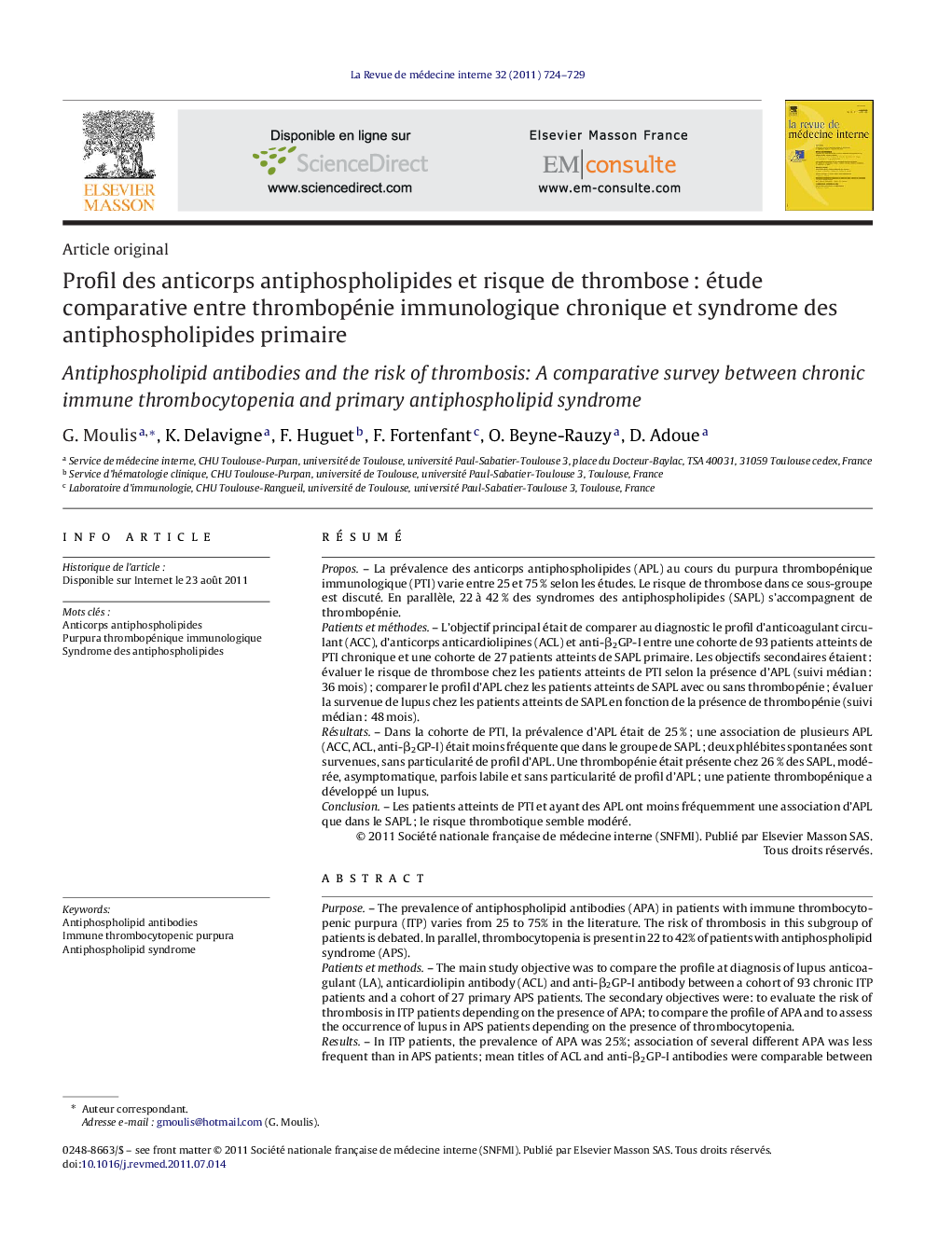| کد مقاله | کد نشریه | سال انتشار | مقاله انگلیسی | نسخه تمام متن |
|---|---|---|---|---|
| 3021817 | 1182382 | 2011 | 6 صفحه PDF | دانلود رایگان |

RésuméProposLa prévalence des anticorps antiphospholipides (APL) au cours du purpura thrombopénique immunologique (PTI) varie entre 25 et 75 % selon les études. Le risque de thrombose dans ce sous-groupe est discuté. En parallèle, 22 à 42 % des syndromes des antiphospholipides (SAPL) s’accompagnent de thrombopénie.Patients et méthodesL’objectif principal était de comparer au diagnostic le profil d’anticoagulant circulant (ACC), d’anticorps anticardiolipines (ACL) et anti-β2GP-I entre une cohorte de 93 patients atteints de PTI chronique et une cohorte de 27 patients atteints de SAPL primaire. Les objectifs secondaires étaient : évaluer le risque de thrombose chez les patients atteints de PTI selon la présence d’APL (suivi médian : 36 mois) ; comparer le profil d’APL chez les patients atteints de SAPL avec ou sans thrombopénie ; évaluer la survenue de lupus chez les patients atteints de SAPL en fonction de la présence de thrombopénie (suivi médian : 48 mois).RésultatsDans la cohorte de PTI, la prévalence d’APL était de 25 % ; une association de plusieurs APL (ACC, ACL, anti-β2GP-I) était moins fréquente que dans le groupe de SAPL ; deux phlébites spontanées sont survenues, sans particularité de profil d’APL. Une thrombopénie était présente chez 26 % des SAPL, modérée, asymptomatique, parfois labile et sans particularité de profil d’APL ; une patiente thrombopénique a développé un lupus.ConclusionLes patients atteints de PTI et ayant des APL ont moins fréquemment une association d’APL que dans le SAPL ; le risque thrombotique semble modéré.
PurposeThe prevalence of antiphospholipid antibodies (APA) in patients with immune thrombocytopenic purpura (ITP) varies from 25 to 75% in the literature. The risk of thrombosis in this subgroup of patients is debated. In parallel, thrombocytopenia is present in 22 to 42% of patients with antiphospholipid syndrome (APS).Patients et methodsThe main study objective was to compare the profile at diagnosis of lupus anticoagulant (LA), anticardiolipin antibody (ACL) and anti-β2GP-I antibody between a cohort of 93 chronic ITP patients and a cohort of 27 primary APS patients. The secondary objectives were: to evaluate the risk of thrombosis in ITP patients depending on the presence of APA; to compare the profile of APA and to assess the occurrence of lupus in APS patients depending on the presence of thrombocytopenia.ResultsIn ITP patients, the prevalence of APA was 25%; association of several different APA was less frequent than in APS patients; mean titles of ACL and anti-β2GP-I antibodies were comparable between the two cohorts; two spontaneous venous thromboses occurred in ITP patients, with no particular profile of APA (median follow-up: 36 months). Thrombocytopenia was present in 26% of APS patients; it was always moderate and asymptomatic, and sometimes intermittent; no particular profile of APA was associated to thrombocytopenia; only one thrombocytopenic patient developed a systemic lupus and no particular profile of APA could be found associated (median follow-up: 48 months).ConclusionITP patients with APA have less frequently an association of different APA than APS patients do; their risk of thrombosis appears low.
Journal: La Revue de Médecine Interne - Volume 32, Issue 12, December 2011, Pages 724–729